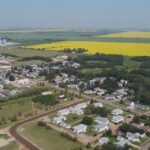In the shadow of Saskatchewan’s agricultural abundance lies a stark paradox: nearly one in six households in the province struggles with food insecurity. While Saskatchewan fields produce crops that feed the world, local community organizers are increasingly stepping up to address the nutritional gaps in their own neighborhoods, developing innovative approaches that may offer sustainable solutions to a growing crisis.
“We’re seeing record numbers at our food bank this year,” explains Melissa Jenkins, director of the Prince Albert Community Food Resource Centre. “It’s not just about providing emergency food anymore—we’re creating systems that empower people to access nutritious food with dignity.”
Across Saskatchewan, grassroots initiatives are transforming the approach to food insecurity. The Prince Albert Food Coalition has pioneered a multi-faceted strategy that includes community gardens, cooking workshops, and food recovery programs that redirect surplus food from grocers to families in need. Their approach moves beyond emergency handouts toward building sustainable food systems.
Data from Food Banks Canada indicates that Saskatchewan has seen a 31% increase in food bank usage since 2019, with children representing nearly 40% of recipients. This troubling trend has catalyzed action among community organizations determined to address both immediate needs and underlying causes.
In response, the Prince Albert Community Garden Network has expanded from three gardens in 2018 to fifteen today, providing growing space for over 300 families. Participants not only harvest fresh produce but also learn growing techniques that can be implemented at home.
“What makes these gardens powerful isn’t just the food they produce,” notes Robert Bratvold, superintendent of the Saskatchewan Rivers Public School Division. “It’s the education component. Students learn where food comes from and develop skills they’ll carry for life.”
Schools have become vital partners in addressing food insecurity. The School Nutrition Program now serves over 5,000 students daily across the province, ensuring children have access to nutritious meals regardless of their home situation. Research published in the Canadian Journal of Public Health demonstrates that such programs significantly improve academic outcomes while reducing behavior issues.
For Indigenous communities, food sovereignty initiatives are reclaiming traditional practices. The Muskoday First Nation’s food security project integrates elder knowledge with contemporary growing techniques, addressing both nutritional needs and cultural connection.
“Food is medicine in our worldview,” explains Elder Sarah Bear. “When we grow food using traditional methods and harvest wild foods, we’re healing not just bodies but spirits.”
The COVID-19 pandemic intensified food insecurity challenges while paradoxically creating new opportunities for innovation. Community organizations pivoted to delivery models, established outdoor markets, and developed online education platforms that continue to serve vulnerable populations today.
Financial barriers remain a significant challenge. A typical Saskatchewan family of four needs approximately $1,200 monthly for a nutritious diet—an impossible sum for many households navigating rising housing costs and stagnant wages. This economic reality underscores that food insecurity is fundamentally an income issue.
“We can grow all the community gardens we want,” acknowledges Jenkins, “but until we address poverty, we’re treating symptoms rather than causes.”
The provincial government recently announced a $3.5 million investment in food security initiatives, though critics argue more comprehensive poverty reduction strategies are needed to create lasting change. Meanwhile, community organizations continue building networks that strengthen local food systems.
As these grassroots efforts expand across Saskatchewan, they offer promising models for addressing food insecurity through community-based approaches. The emerging networks of gardens, education programs, and resource-sharing initiatives demonstrate that effective solutions often grow from the ground up.
What remains to be seen is whether these community innovations can be sustained and scaled to address the systemic inequities that leave too many Saskatchewan residents uncertain about their next meal. Can the province that feeds the world ensure none of its own citizens go hungry?

























